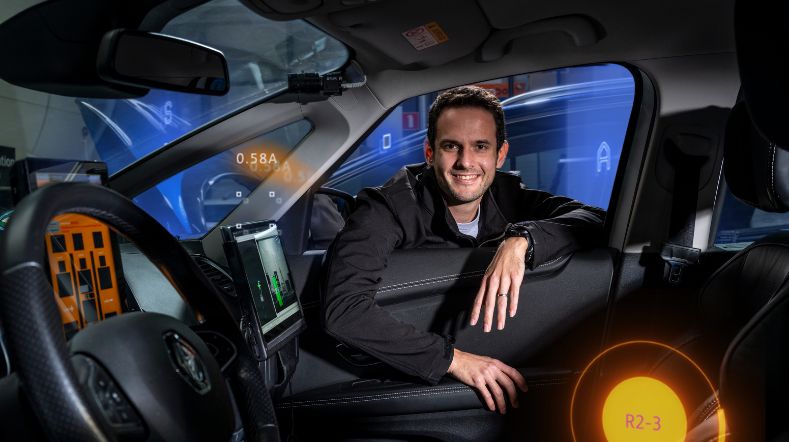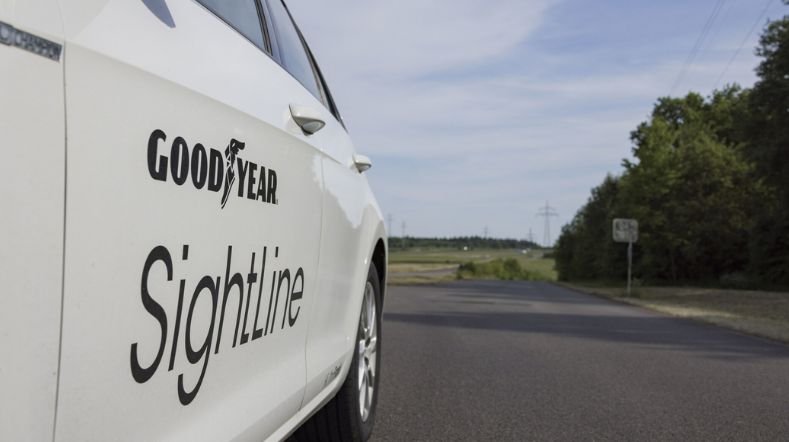
TNO and Goodyear at CES 2024: real-time tyre information to enhance vehicle safety
At the CES tech fair in Las Vegas, Goodyear and TNO showcase an applied innovation that could significantly improve vehicle safety. Jorn Gijsbers and Ron Wouters (TNO) explain how real-time tyre information can help prevent accidents and create new revenue models.
CES Las Vegas
Transparent televisions, flying cars, robotic construction cranes, and lots of electronics with AI applications. The diversity of innovations at the annual Consumer Electronics Show is enormous. With an area of about 40 football fields, more than 3,200 exhibitors and over 135,000 visitors, CES is by far the largest and most important tech show in the world.
Although originally an electronics fair, almost all sectors are now represented, including automotive. For more and more car manufacturers, CES is now a more important stage than the usual car shows. They not only showcase futuristic prototypes but also introduce new production models. On this global stage, TNO takes the spotlight by introducing a technology with Goodyear that can significantly enhance vehicle safety.

Smarter tyres
At TNO, Jorn Gijsbers, Client Partner, and Ron Wouters, System Engineer, have worked in recent years to develop the innovation with Goodyear. Gijsbers: "Goodyear, one of the world's largest tyre manufacturers, sees great potential for tyres as an information source, globally known as the development of 'Intelligent Tyre.' The car has evolved from a hardware product to a software-defined vehicle. However, tyres still form the only contact point between the car and the road, so they can contribute significantly to vehicle safety."
"With the Goodyear SightLine program, they have developed a series of intelligent tyre technologies that provide insights into actual driving conditions regarding the tyre, the vehicle, and the road through advanced algorithms and real-time monitoring. Now, together with TNO, they are taking a step to further increase that safety. We do this by integrating tyre intelligence into an ABS system. An ABS system enhances the controllability of a car and also shortens the braking distance by momentarily reducing the braking force on a wheel when it is at risk of locking.
ABS using tyre information
The collaboration between TNO and Goodyear has a long history. Gijsbers: "Goodyear has been using the Delft-Tyre simulation model that we developed with TU Delft for many years. About 3 years ago, the partnership was revitalised, thanks to a TNO paper on the potential use of real-time tyre information in an ABS system. All modern vehicles have an ABS system, making it an interesting first application for tyre intelligence." Ron Wouters explains how the system works.
"An anti-lock braking system keeps the vehicle controllable during an emergency stop. It works optimally with a new set of tyres. But due to wear, the parameters of those tyres change: you have less traction than the ABS system assumes. Through real-time monitoring, the ABS system gains insight into the current situation: the state of the tyre, including wear and tyre pressure, as well as the condition of the road and weather conditions. A tyre with little tread under wet, slippery conditions has a significantly longer braking distance than a new tyre on dry asphalt. With that information, the ABS is controlled for optimal performance."
Braking distance shortened by up to 1.8 meters
The test results of Goodyear's Sightline ABS system using real-time tyre information are promising. TNO has developed a functional demonstrator for research and development with Goodyear. Initial tests and calculations indicate that the ABS works more efficiently, and the braking distance can be shortened by up to 1.8 meters. Wouters: "That may not seem like much, but it is relatively significant on a vehicle's braking distance."
In addition to safety, intelligent tyre monitoring also offers economic benefits: "With the increasing electrification, tyres will be one of the few parts of a car subject to periodic maintenance. You try to use a tyre as long as possible. For that, conditions such as tyre pressure, balancing, and alignment all need to be optimal. You preferably want to monitor all these aspects in real-time to intervene at the right moment, not at fixed service intervals. A periodic check costs money, so you save money by not conducting unnecessary checks. And if you intervene at the right time, for example, when the tyre pressure is too low, you prevent the costs of extra wear. So, smarter and more cost-effective maintenance is an important aspect."
Especially in the US, as Jorn Gijsbers knows: "In large fleets, truck tyres are often leased per kilometer from tyre manufacturers. If the tyres last longer, it means significant cost savings for the manufacturer. We see that intelligent tyre information systems also lead to new revenue models."

"In large fleets, truck tyres are often leased per kilometer from tyre manufacturers. If the tyres last longer, it means significant cost savings for the manufacturer."
Essential for autonomous driving strategy
TNO expects this tyre technology to be crucial for the development of autonomous vehicles. "Autonomous vehicles must constantly know the current braking distance under all conditions," explains Wouters. "The braking distance of a car varies greatly depending on tyre and driving conditions. If the weather is bad, the driver decides to keep more distance and drive more slowly. Without a driver, that information must come from somewhere else. Algorithms and sensors can provide insights into the tyre's condition, road conditions, and the weather. These three elements together form important input for autonomous vehicles."
In addition to ABS systems, Wouters sees many promising applications for tyre information. "For example, in safety-critical automated systems for 'Automated Evasive Steering.' These systems can make the assessment to brake or swerve in the event of an impending accident. With detailed tyre information, these systems can better assess when to intervene and thus make vehicles safer. In the coming years, we will work systematically with Goodyear on the implementation of tyre information systems for vehicles to further increase safety."
Autonomous driving is maturing
At CES, both TNO representatives see that autonomous driving is still a very important theme in the tech world. "Both major tech players and automotive OEMs (Original Equipment Manufacturers) are heavily investing in it," notes Gijsbers.
"You can see that the technology is becoming more mature and commonplace and enriched with a lot of AI. Here, we fully autonomously rode in a WeRide van through the busy streets of Las Vegas, very impressive."
In addition to the automotive industry, other sectors are also actively involved in automation. Wouters mentions construction as an example. "Hyundai is showcasing a fully electric and autonomous excavator here. It uses a control platform that Hyundai offers as open source, so all parties can develop products and applications on it."
To steer this development, standards are indispensable, foresees Gijsbers. "When you look at automatic vehicles, a lot is already possible, as seen in our taxi ride. But how do you bring everything together for a successful implementation? TNO can make a significant contribution to these developments by helping to connect the various technologies. Our broad orientation and independent position allow us to connect the parties with each other."
Get inspired
Getting on board with autonomous transport? Five things you need to know


Connected mobility


Working on safer self-driving cars


Goodyear and TNO further integrate tyre and vehicle technology to mitigate crashes in adverse weather


TNO CEYAS offers logistics partners advantage yard automation




